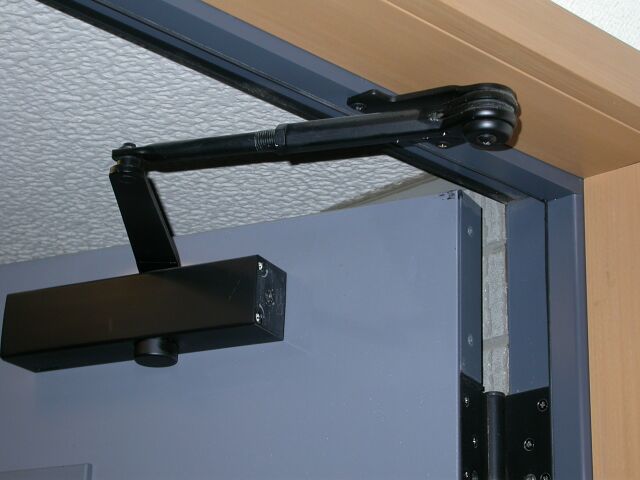Door closer
A door closer is a hydraulic device that is used to automatically close a door after it has been opened. Door closers are commonly used as a fire prevention measure, typically installed on fire doors, as well as helping to prevent draughts.
The most common types of door closer include:
Surface-mounted door closers are the most common type, as they are comparatively cost-effective and easy to install. They are fitted to the door frame behind the door, next to the hinge. The arm of the closer retracts to closed configuration as the door closes.
As well as the standard, double-lever arm, there are different kinds of arms available for surface-mounted door closers, depending on the application and to provide more functionality. These include:
- Hold open arm: By opening the door to a certain degree, a nut is tightened which causes the arm to stick at an open point.
- Dedicated parallel arm: In the closed position it lays parallel with the door instead of projecting outwards, although lacks the strength of the standard arm.
- Stop arm: Prevents the door from opening too far and hitting a wall or other obstacle.
Concealed door closers are hidden within the door jamb and are often used when aesthetics of the door is an important factor. This type fits in the morticed recesses in the door and the frame, allowing it to be completely concealed when the door is closed. This type is typically used for ‘double-acting’ doors, i.e. those that swing both ways; usually in high-traffic applications such as a busy office building door.
Floor closers are similar in that they are concealed within the floor and are not visible when the door is opened. Fitted into the underside of the door is a bar which controls the closing action, usually with an open setting that allows them to be left open. They are typically used with pivot hinges rather than butt hinges, which are stronger and more durable, and can often be found on glass front doors of commercial buildings.
[edit] Related articles on Designing Buildings Wiki
Featured articles and news
Infrastructure that connect the physical and digital domains.
Harnessing robotics and AI in challenging environments
The key to nuclear decommissioning and fusion engineering.
BSRIA announces Lisa Ashworth as new CEO
Tasked with furthering BSRIA’s impressive growth ambitions.
Public buildings get half a million energy efficiency boost
£557 million to switch to cleaner heating and save on energy.
CIOB launches pre-election manifesto
Outlining potential future policies for the next government.
Grenfell Tower Inquiry announcement
Phase 2 hearings come to a close and the final report due in September.
Progress from Parts L, F and O: A whitepaper, one year on.
A replicated study to understand the opinion of practitioners.
ECA announces new president 2024
Electrical engineer and business leader Stuart Smith.
A distinct type of countryside that should be celebrated.
Should Part O be extended to existing buildings?
EAC brands heatwave adaptation a missed opportunity.
Definition of Statutory in workplace and facilities management
Established by IWFM, BESA, CIBSE and BSRIA.
Tackling the transition from traditional heating systems
59% lack the necessary information and confidence to switch.
The general election and the construction industry
As PM, Rishi Sunak announces July 4 date for an election.
Eco apprenticeships continue help grow green workforce
A year after being recognised at the King's coronation.
Permitted development rights for agricultural buildings
The changes coming into effect as of May 21, 2024.






















